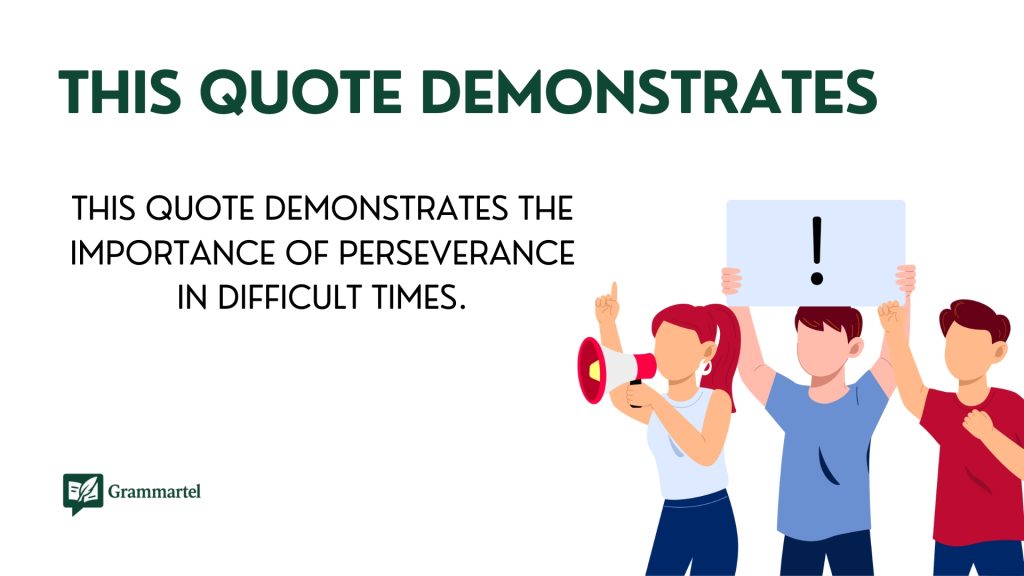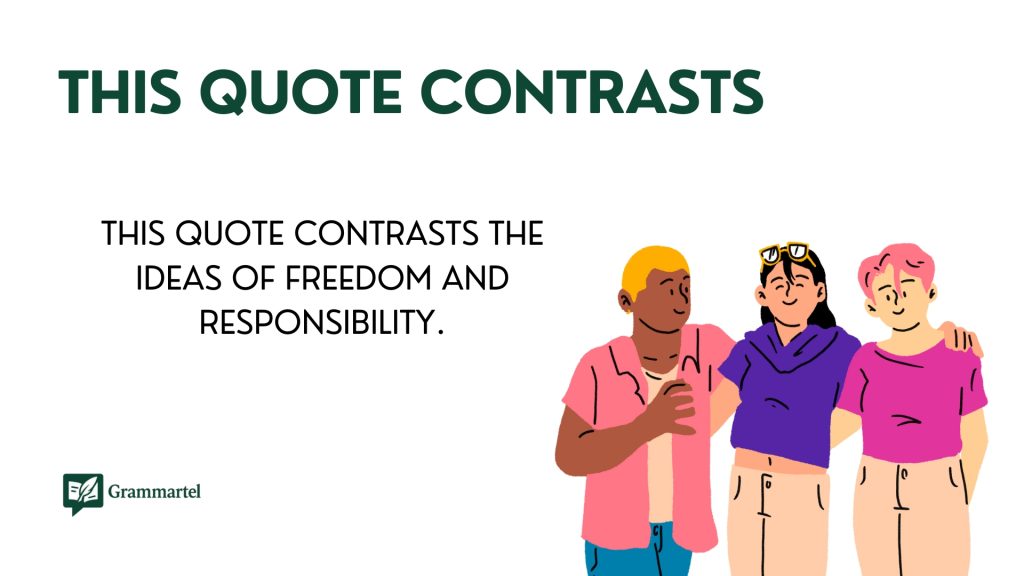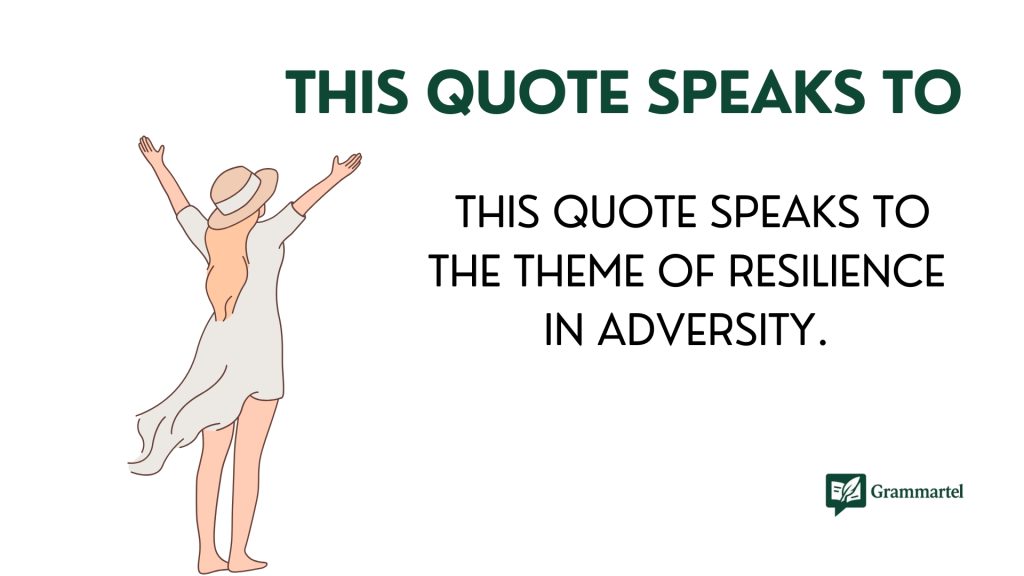When discussing quotes, it can get repetitive using the same phrases like “this quote shows.” Thankfully, there are many creative alternatives that can help spice up your writing. Whether you’re writing an essay, a speech, or even a social media post, using different ways to introduce quotes can make your work more engaging and dynamic. Below are 40 alternatives you can use in various contexts, each with examples for clarity.
What Does “This Quote Shows” Mean?
The phrase “this quote shows” is often used to highlight a specific idea, theme, or message conveyed by a piece of text or dialogue. It signals that the quote provides evidence or insight into a particular concept being discussed. For example, if you’re analyzing a literary work, you might say, “This quote shows the character’s inner conflict,” to point out how the author uses words to reveal deeper emotions or struggles.
When to Use “This Quote Shows”
You’d typically use “this quote shows” when you want to draw attention to how a quote supports your argument or analysis. It’s especially useful in essays, discussions, or any situation where you’re interpreting a source and need to clarify its meaning. Just make sure you follow up with an explanation of how it shows that particular idea – simply saying “this quote shows” isn’t enough on its own. It’s like setting up a stage for your argument and then explaining why the performance matters.
40 Creative Alternatives to Say “This Quote Shows”
1. This Quote Demonstrates

- Meaning: Indicates what the quote reveals or proves.
- Explanation: Shows a clear connection between the quote and its deeper meaning or implication.
- Example: This quote demonstrates the importance of perseverance in difficult times.
- Best Use: In analytical writing, showing a cause-and-effect relationship.
- Worst Use: When the quote doesn’t clearly support the argument.
- Tone: Analytical, informative.
2. This Quote Illustrates
- Meaning: Explains or makes an idea clearer.
- Explanation: Provides a visual or conceptual understanding of an idea.
- Example: This quote illustrates how leadership requires empathy.
- Best Use: When making abstract concepts more concrete.
- Worst Use: When there is little explanation or context for the quote.
- Tone: Clarifying, descriptive.
3. This Quote Reveals
- Meaning: Unveils a hidden truth or insight.
- Explanation: Exposes something not immediately obvious.
- Example: This quote reveals the vulnerability of human nature.
- Best Use: When pointing out an overlooked or hidden message.
- Worst Use: When the quote is too vague to reveal anything concrete.
- Tone: Revealing, thoughtful.
4. This Quote Emphasizes
- Meaning: Highlights the significance of a particular idea.
- Explanation: Focuses attention on the importance of something in the quote.
- Example: This quote emphasizes the value of hard work.
- Best Use: When trying to reinforce a core message.
- Worst Use: When the quote does not truly emphasize anything.
- Tone: Strong, reinforcing.
Don’t miss : 40 Other Ways to Say “Firstly, Secondly, Thirdly” (With Examples).
5. This Quote Confirms
- Meaning: Supports or validates a point.
- Explanation: Gives evidence that aligns with the argument.
- Example: This quote confirms that optimism can lead to success.
- Best Use: When the quote is used to back up an argument or claim.
- Worst Use: If the quote contradicts the claim being made.
- Tone: Affirmative, validating.
6. This Quote Suggests
- Meaning: Implies or hints at something.
- Explanation: Offers an idea without directly stating it.
- Example: This quote suggests that failure is a part of the journey to success.
- Best Use: When presenting an idea indirectly.
- Worst Use: When the suggestion is too vague to be meaningful.
- Tone: Thoughtful, subtle.
7. This Quote Highlights
- Meaning: Draws attention to something important.
- Explanation: Stresses a key point from the quote.
- Example: This quote highlights the impact of kindness on society.
- Best Use: In discussions where the main point needs to be made clear.
- Worst Use: When the quote doesn’t truly highlight anything of importance.
- Tone: Direct, focused.
8. This Quote Captures
- Meaning: Expresses an idea in a concise or compelling way.
- Explanation: Summarizes a complex idea in a few words.
- Example: This quote captures the essence of determination.
- Best Use: When the quote succinctly expresses a larger theme.
- Worst Use: When the quote is too convoluted to capture a clear meaning.
- Tone: Summarizing, precise.
9. This Quote Portrays
- Meaning: Depicts or paints a picture of a concept or idea.
- Explanation: Creates an image or mental representation of a concept.
- Example: This quote portrays the struggle between good and evil.
- Best Use: In literary analysis or when discussing figurative language.
- Worst Use: When the quote lacks descriptive qualities.
- Tone: Descriptive, creative.
10. This Quote Supports
- Meaning: Provides backing or reinforcement for an argument.
- Explanation: Strengthens a point by providing additional evidence.
- Example: This quote supports the idea that true happiness comes from within.
- Best Use: When the quote is used to back up an argument or claim.
- Worst Use: If the quote doesn’t support the argument effectively.
- Tone: Supportive, reinforcing.
11. This Quote Expresses
- Meaning: Conveys an idea or feeling.
- Explanation: Puts forth an emotion, opinion, or thought.
- Example: This quote expresses the importance of self-reflection.
- Best Use: When highlighting personal thoughts or emotions.
- Worst Use: When the quote doesn’t clearly express anything meaningful.
- Tone: Expressive, personal.
12. This Quote Reveals
- Meaning: Discloses something about the subject matter.
- Explanation: Opens up a deeper understanding of an idea or theme.
- Example: This quote reveals the inner conflict faced by the protagonist.
- Best Use: In literary analysis or deeper discussions.
- Worst Use: When the revealed meaning is irrelevant.
- Tone: Thoughtful, introspective.
13. This Quote Demonstrates
- Meaning: Provides an example or proof of something.
- Explanation: Shows through example how something works.
- Example: This quote demonstrates the power of perseverance in adversity.
- Best Use: When illustrating a concept with a concrete example.
- Worst Use: If the quote doesn’t directly demonstrate the point.
- Tone: Explanatory, illustrative.
14. This Quote Reinforces
- Meaning: Strengthens a previously stated idea.
- Explanation: Builds upon or supports an earlier argument or point.
- Example: This quote reinforces the idea that success is built on failure.
- Best Use: When further elaborating on an argument.
- Worst Use: When the quote doesn’t add any new insight.
- Tone: Strengthening, supportive.
15. This Quote Contrasts

- Meaning: Highlights a difference or opposition between ideas.
- Explanation: Shows a contrast between two opposing thoughts or arguments.
- Example: This quote contrasts the ideas of freedom and responsibility.
- Best Use: In discussions comparing opposing views.
- Worst Use: If the contrast is unclear or irrelevant.
- Tone: Comparative, analytical.
16. This Quote Provides Insight
- Meaning: Offers a deeper understanding or perspective.
- Explanation: Allows for a clearer or more meaningful view on a topic.
- Example: This quote provides insight into the human condition.
- Best Use: When delving into philosophical or abstract concepts.
- Worst Use: When the insight is superficial or unclear.
- Tone: Thoughtful, reflective.
17. This Quote Reveals a Truth
- Meaning: Exposes a universal or profound truth.
- Explanation: Uncovers a fundamental idea or reality about life.
- Example: This quote reveals a truth about the nature of human relationships.
- Best Use: When sharing a deep or universal truth.
- Worst Use: When the truth revealed is not widely accepted.
- Tone: Profound, reflective.
18. This Quote Illustrates a Concept
- Meaning: Explains or demonstrates a specific idea.
- Explanation: Shows how a particular concept works or manifests.
- Example: This quote illustrates the concept of self-reliance.
- Best Use: When breaking down abstract concepts.
- Worst Use: If the concept isn’t clearly explained.
- Tone: Educational, explanatory.
19. This Quote Clarifies
- Meaning: Makes something easier to understand.
- Explanation: Removes confusion or ambiguity.
- Example: This quote clarifies the true meaning of friendship.
- Best Use: When simplifying complex or unclear ideas.
- Worst Use: If the quote creates more confusion.
- Tone: Clarifying, simplifying.
20. This Quote Strengthens the Argument
- Meaning: Adds support to a previously stated argument.
- Explanation: Bolsters a claim or belief with extra validation.
- Example: This quote strengthens the argument that education is key to success.
- Best Use: When making an argument more persuasive.
- Worst Use: If the quote weakens the argument or contradicts it.
- Tone: Persuasive, reinforcing.
21. This Quote Underlines
- Meaning: Emphasizes or highlights a specific aspect.
- Explanation: Stresses a particular point or idea that is important.
- Example: This quote underlines the importance of honesty in relationships.
- Best Use: When trying to accentuate a crucial point.
- Worst Use: If the point isn’t clear or relevant.
- Tone: Emphasizing, assertive.
22. This Quote Suggests a Solution
- Meaning: Points to a way of resolving an issue or problem.
- Explanation: Offers a potential way forward or answer to a question.
- Example: This quote suggests a solution to overcoming self-doubt.
- Best Use: When proposing ways to address a challenge.
- Worst Use: If the quote doesn’t provide any viable solutions.
- Tone: Problem-solving, hopeful.
23. This Quote Reflects
- Meaning: Shows or mirrors an idea, feeling, or situation.
- Explanation: Provides a reflection or echo of a broader concept.
- Example: This quote reflects the societal views on success.
- Best Use: When discussing societal or cultural perspectives.
- Worst Use: If the reflection isn’t accurate or relevant.
- Tone: Reflective, thoughtful.
24. This Quote Reveals an Irony
- Meaning: Unveils a contrast between appearance and reality.
- Explanation: Exposes a situation where expectations are opposite to what happens.
- Example: This quote reveals an irony in the character’s actions.
- Best Use: When pointing out contradictions in the text or situation.
- Worst Use: If the irony isn’t clearly explained or identified.
- Tone: Ironical, analytical.
25. This Quote Speaks to

- Meaning: Expresses a particular theme or idea.
- Explanation: Addresses a specific subject or concept.
- Example: This quote speaks to the theme of resilience in adversity.
- Best Use: When focusing on a specific thematic element.
- Worst Use: If the connection to the theme is unclear.
- Tone: Thematic, expressive.
26. This Quote Highlights the Importance
- Meaning: Focuses on the critical role or value of something.
- Explanation: Stresses how vital a concept or idea is.
- Example: This quote highlights the importance of kindness in leadership.
- Best Use: In discussions where priority or value needs to be made clear.
- Worst Use: If the importance isn’t well-supported by the quote.
- Tone: Assertive, prioritizing.
27. This Quote Serves as a Reminder
- Meaning: Reinforces a particular lesson or principle.
- Explanation: Calls attention to something that might have been forgotten or overlooked.
- Example: This quote serves as a reminder that time is precious.
- Best Use: When offering a brief yet powerful piece of advice.
- Worst Use: If the reminder feels unnecessary or redundant.
- Tone: Reminder, reflective.
28. This Quote Sheds Light on
- Meaning: Reveals or clarifies a situation or concept.
- Explanation: Offers an explanation or new perspective.
- Example: This quote sheds light on the human desire for connection.
- Best Use: In situations where understanding is deepened.
- Worst Use: If the light shed doesn’t provide new insights.
- Tone: Enlightening, clarifying.
29. This Quote Demonstrates a Contradiction
- Meaning: Shows a conflict or inconsistency.
- Explanation: Exposes a contrast between two opposing elements.
- Example: This quote demonstrates a contradiction between individualism and community.
- Best Use: When analyzing contradictory ideas or themes.
- Worst Use: If the contradiction is not evident or relevant.
- Tone: Analytical, challenging.
30. This Quote Unveils
- Meaning: Reveals something previously hidden or unclear.
- Explanation: Opens up a new perspective or piece of information.
- Example: This quote unveils the true motivation behind the character’s actions.
- Best Use: When revealing key plot points or insights.
- Worst Use: If the unveiling is inconsequential.
- Tone: Revealing, dramatic.
31. This Quote Signifies
- Meaning: Represents or stands for a particular concept or idea.
- Explanation: Shows that something symbolizes a larger meaning.
- Example: This quote signifies the importance of love in healing.
- Best Use: When connecting symbols to greater meanings.
- Worst Use: If the symbolism isn’t clear.
- Tone: Symbolic, insightful.
32. This Quote Conveys
- Meaning: Transmits a particular message or idea.
- Explanation: Communicates a thought or emotion effectively.
- Example: This quote conveys the idea that actions speak louder than words.
- Best Use: When a clear message is delivered.
- Worst Use: If the message is muddled or unclear.
- Tone: Direct, clear.
33. This Quote Clarifies a Concept
- Meaning: Makes a concept easier to understand.
- Explanation: Explains a difficult or abstract idea in simpler terms.
- Example: This quote clarifies the concept of true friendship.
- Best Use: When breaking down complex ideas.
- Worst Use: If the clarification doesn’t resolve confusion.
- Tone: Educational, explanatory.
34. This Quote Teaches
- Meaning: Provides a lesson or moral.
- Explanation: Imparts a valuable lesson or piece of wisdom.
- Example: This quote teaches the importance of humility.
- Best Use: When offering guidance or advice.
- Worst Use: If the lesson is too obvious or cliché.
- Tone: Instructional, moral.
35. This Quote Warns
- Meaning: Gives a cautionary message.
- Explanation: Alerts the reader to potential dangers or risks.
- Example: This quote warns of the consequences of greed.
- Best Use: When offering a warning or caution.
- Worst Use: If the warning feels unnecessary.
- Tone: Cautionary, serious.
36. This Quote Reflects a Paradox
- Meaning: Shows two contradictory ideas that may both be true.
- Explanation: Exposes a paradox in logic or thought.
- Example: This quote reflects a paradox in the nature of freedom.
- Best Use: When analyzing conflicting ideas or paradoxes.
- Worst Use: If the paradox is too subtle or unclear.
- Tone: Thought-provoking, puzzling.
37. This Quote Warns of a Pitfall
- Meaning: Cautions against a potential trap or failure.
- Explanation: Highlights the risks of a certain action or mindset.
- Example: This quote warns of the pitfall of too much ambition.
- Best Use: When discussing the consequences of negative behavior.
- Worst Use: If the pitfall is irrelevant to the context.
- Tone: Cautionary, preventative.
Take a look at this : 40 Heartfelt Alternatives to Say “I Am Praying for You” (With Examples).
38. This Quote Reflects Wisdom
- Meaning: Shows deep insight or knowledge.
- Explanation: Demonstrates an understanding based on experience.
- Example: This quote reflects wisdom about handling life’s challenges.
- Best Use: When sharing profound or age-old wisdom.
- Worst Use: If the wisdom feels superficial.
- Tone: Wise, insightful.
39. This Quote Shows a Pattern
- Meaning: Identifies a recurring theme or trend.
- Explanation: Points to a consistent element or idea over time.
- Example: This quote shows a pattern of resilience in human nature.
- Best Use: In discussions about trends or recurring themes.
- Worst Use: When the pattern isn’t clearly established.
- Tone: Analytical, systematic.
40. This Quote Expands

- Meaning: Broadens the understanding of a subject.
- Explanation: Provides more information or perspective.
- Example: This quote expands the concept of personal growth.
- Best Use: When developing a broader understanding of a topic.
- Worst Use: If the expansion feels irrelevant.
- Tone: Expansive, enlightening.
Conclusion
In conclusion, varying how you introduce quotes keeps your writing fresh and engaging. It not only avoids repetition but also adds a unique voice to your work. Try mixing these alternatives in your writing to improve flow and make your points stand out.
Enhance your writing speed using Grammartel smart suggestions.

